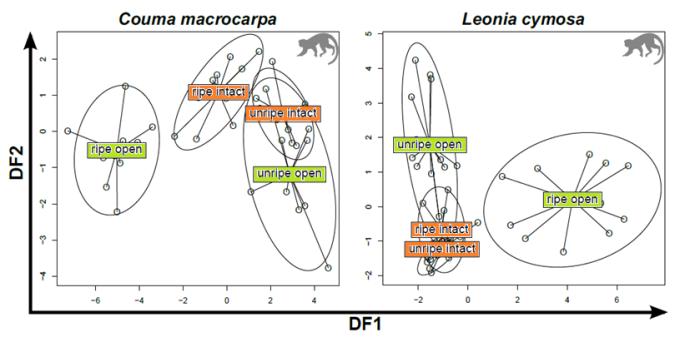Discussion
The results of the present study show that spider monkeys (Ateles Geoffroyi) have a well-developed ability to discriminate between the ripe and unripe odorants of C.macrocarpa intact and L.cymosa open, and also between the majority of their variations tested. However, they failed to discriminate between the ripe and unripe odorants of L.cymosa intact.
In the case of the partially modified unripe odours, it seemed that single variations of a chemical or group compounds does not affect the discrimination of those odours. However, it could be that the chemical or group of compounds responsible for the discrimination was not one of those modified, and therefore, not detected.
Also it needs to be taken in account that the odorants used were not 100% exact reproductions of those found in the natural fruits. The chemical composition obtained may have not detected some compounds in really low concentrations, and also, when manipulating volatile compounds, it is hard to keep the concentrations accurately.
Nevertheless, the fact that spider monkeys have a high sensitivity for food-associated odorants, and that can discriminate ripeness odours in fruits, seems to indicate that the sense of smell plays a vital role in the food selection process.
L.cymosa presents a stronger signalling in the pulp, which means that a higher concentration of odorific volatile compounds are located in the inside of the fruit. This is a less costly strategy, and has other benefits, such the non attraction of insects.
This fruit is only dispersed by primates, which do not rely on the sense of smell for foraging. Therefore, it makes sense that the fruit do not focus on an outer odorific signalling, and this could be why spider monkeys were not able to discriminate between the odours of ripe and unripe L.cymosa for the intact fruit.
However, C.macrocarpa presents a stronger signalling in the husk, which is a more costly strategy due to the constant release of volatile compounds.
Alternatively, this fruit is also dispersed by bats, which rely on chemosensation in the food-search phase. So, even though monkeys would not use that cue to locate the food, bats would.
This seems to be in the line of the "Dispersal syndrome hypothesis", which states that plant species evolved to specialize on a certain frugivore guild (e.g. primates or bats), adapting their fruits to the physical, nutritional and sensory capacities of their respective dispersal vector.

Responsible for this page:
Director of undergraduate studies Biology
Last updated:
07/08/15
